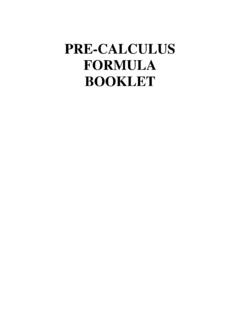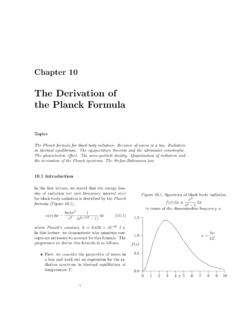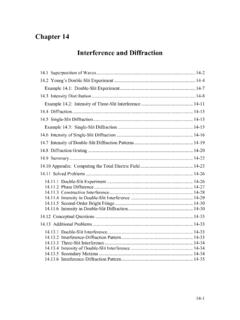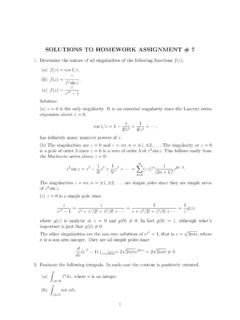Transcription of Analog and Digital Signals, Time and Frequency ...
1 1 Analog and Digital Signals, Analog and Digital Signals, Time and FrequencyTime and FrequencyRepresentation of Representation of SignalsSignalsCSE 3213, Fall 2010 Instructor: N. VlajicRequired reading:Garcia , Data vs. SignalData vs. Signal Analog vs. Digital Analog Signals Simple Analog Signals Composite Analog Signals Digital Signals3 Data vs. SignalDataData information formatted in human/machine readable form examples: voice, music, image, fileSignal Signal electric or electromagnetic representation of data transmission media work by conducting energy along a physicalpath; thus, to be transmitted, data must be turned into energy inthe form of electro-magnetic signalsTransmissionTransmission communication of datathrough propagation andprocessing of signalsChannel or Communication MediumCodingReceiverSenderDecodingSignal SignalDataDataIdea, Feeling, Knowledge4 Signal RepresentationSignal RepresentationSignal Representation typically in 2D space, as a function of time, spaceor Frequency when horizontal axis is time, graph displaysthe value of a signal at one particular point in spaceas a function of time when horizontal axis is space, graph displaysthe value of a signal at one particular point intimeas a function of spacetimespaceThe time- and space- representation of a signal often resemble each other.
2 Though the signal envelope in the space-representation is different (signal attenuates over distance).5 Signal Representation (cont.) [ signal in time and space]6 Data vs. Signal Analog vs. DigitalAnalog vs. Digital Analog Signals Simple Analog Signals Composite Analog Signals Digital Signals7 Analog vs. DigitalAnalog vs. Digital Data Analog vs. Digital Data Analog dataanalog data representation variable takeson continuous values in some interval, voice, temperature, etc. Digital datadigital data representation variable takes on discrete (a finite & countable numberof) values in a given interval, text, digitized images, vs. Digital SignalAnalog vs. Digital Signal Analog signalanalog signal signal that is continuous in timeand can assume an infinitenumber of values in a given range (continuous intime and value) discrete ( Digital ) signaldiscrete ( Digital ) signal signal that is continuous in timeand assumes only a limitednumber of values (maintains aconstant level and then changes to anotherconstant level)8 Analog vs.
3 Digital (cont.)Both Analog and Digital data can be transmittedusing either Analog or Digital : Analog signaling of Analog and Digital will talk more about this later ..9 Periodic vs. Periodic vs. AperiodicAperiodicSignals Signals periodic signalperiodic signal completes a pattern withinsome measurable time frame, called a period(T), and then repeats that pattern over sub-sequent identical periods T - smallest value that satisfies the equation T is (typically) expressed in seconds aperiodicaperiodicsignalsignal changes without exhibitinga pattern that repeats over time+ =+ ,-t s(t),T)s(t t. s. RTtt+Tperiodic Analog signalperiodic Digital signalAnalog vs. Digital (cont.)t+2T10 Data vs. Signal Analog vs. Digital Analog SignalsAnalog Signals Simple Analog Signals Composite Analog Signals Digital Signals1112 Analog SignalsClassification of Classification of Analog SignalsAnalog Signals(1) Simple Analog SignalSimple Analog Signal cannot be decomposed into simpler signals sinewave most fundamental form of periodicanalogsignal mathematically described with 3 parameters( ) peak amplitudepeak amplitude(A) absolute value of signal shighest intensity unit:volts [V]( ) frequencyfrequency(f) number of periods in one second unit:hertz [Hz] = [1/s] inverse of period (T)!
4 ( ) phase phase ( ) absolute position of the waveform relative to an arbitrary origin unit:degrees [ ]or radians [rad](2) Composite Analog SignalComposite Analog Signal composed of multiple sinewaves)ftsin(2As(t) + = AT = 1/fThe origin is usually taken as the last previous passage through zero from the negative to the positive [s]0[s]13 measured in degreesor radians 360 = 2 rad 1 = 2 /360 rad 1 rad = (360/2 ) = phase shift of 360 = shift of 1 complete period phase shift of 180 = shift of 1/2 period phase shift of 90 = shift of 1/4 period = 0 or 360 = 90 = 180 Simple Analog SignalsPhase in SimplePhase in SimpleAnalog SignalsAnalog Signals5V1 SignalsExample [ period and Frequency ]1012 Hzterahertz (THz)10 12spicoseconds (ps)109 Hzgigahertz (GHz)10 9snanoseconds (ns)10 6s10 3s1 sEquivalent106 Hzmegahertz (MHz)microseconds ( s)
5 103 Hzkilohertz (KHz)milliseconds (ms)1 Hzhertz (Hz)seconds (s)EquivalentUnitUnit(a) Express a period of 100 ms in ms = 100 10-3s = 100 10-3 106 s = 105 s(b) Express the corresponding Frequency in ms = 100 10-3s = 10-1sf= 1/10-1Hz = 10 10-3 KHz = 10-2 KHzunits of period and respective frequency15 Simple Analog Signals rate of signal change with respect to time change in a short span of time high freq. change over a long span of time low freq. signal does not change at all zero never completes a cycle T= f=0, DC sig. signal changes instantaneously completes a cycle in T=0 f= Time Domain Plot Time Domain Plot specifies signal amplitude at each instant of time does NOT express explicitly signal s phase and frequencyFrequency Domain Plot Frequency Domain Plot specifies peak amplitude with respect to freq.
6 Phase CANNOT be shown in the Frequency domainFrequency in SimpleFrequency in SimpleAnalog SignalsAnalog Signals????16 One spike in Frequency domainshows two characteristics of the signal: spike position = signal Frequency ,spike height = peak signals are best represented in the Frequency signals are best represented in the Frequency Analog Signals17 Simple Analog [ time vs. Frequency domain]18 Fourier AnalysisFourier Analysis any composite signalcan be represented as a combination of simple sine waveswith different frequencies, phases and amplitudes periodiccomposite signal(period=T, freq. = f0=1/T) can be represented as a sum of simple sines and/or cosines known as Fourier series: f0is referred to as fundamental Frequency integer multiples of f0are referred to as harmonicsComposite Analog )tfsin(2A)tfsin(2As(t)222111++++= With the aid of good table of integrals,it is easy to determine the Frequency -domain nature of many signals.
7 [] =++=1n0n0n0t)nfsin(2Bt)nfcos(2A2As(t) dt, n = 0,1,2, ..t)nfs(t)cos(2T2AT00n = dt, n = 1,2,3, ..t)nfs(t)sin(2T2BT00n = 19 Composite Analog Signals (cont.)Angular FrequencyAngular Frequency aka radian Frequency number of 2 revolutionsduring a single period of a given signal simple multiple of ordinary frequencyf2 T2 ==[] =++=1n0n0n0t)sin(nBt)cos(nA2As(t) 0,1,2,..nt)dtns(t)cosT2AT0n== ,(0 1,2,..nt)dtns(t)sinT2BT0n== ,(0 20 Composite Analog Signals (cont.)Example [ periodic square wave ]..(5f)t)sin(25 4A(3f)t)sin(23 4 Aft)sin(2 4As(t)+++= three harmonicsadding three harmonicsWith three harmonics we get an approximation of a square get the actual square, all harmonics up to should be three harmonics we get an approximation of a square get the actual square, all harmonics up to should be DC component!
8 !!21 Analog Signals (cont.)Example [ composite Analog signal ]22 Composite Analog Signals (cont.) range (set) of frequencies that signal containsFrequency SpectrumFrequency Spectrumof of Analog Analog SignalSignal width of signal spectrum: B = fhighest-flowestAbsolute BandwidthAbsolute Bandwidthof of Analog Analog SignalSignal range of frequencies where signal contains mostof its power/energyEffective BandwidthEffective Bandwidthof of Analog Analog SignalSignalsquare wave3-harmonic representation23 Example [ Frequency spectrum and bandwidth of Analog signal ]A periodic signal is composed of five sinewaves with frequencies of 100,300, 500, 700 and 900 is the bandwidthof this signal?Draw the Frequency spectrum, assuming all components have a max amplitude of Analog Signals (cont.)
9 Solution:B = fhighest-flowest= 900 - 100 = 800 HzThe spectrum has only five spikes, at 100, 300, 500, 700, and Analog Signals (cont.)()()xsin(x)or f f sin T nT nsinT2A Example [ Frequency spectrum of a data pulse ]What happens if 0 ???envelope of Frequency spectrumaperiodic signal continuous freq. spectrumperiodic signal discrete freq. spectrum25 Composite Analog Signals (cont.) no transmission medium is perfect eachmedium passes some frequencies and blocks or weakens others composite signal sent at one end of (comm. channel), may notbe received in the same form at the other end passing a square wave through any mediumwill alwaysdeform the signal !!!Composite Signals andComposite Signals andTransmission MediumTransmission Medium range of frequencies passed by the channel difference between highest and lowest frequencythat channel can satisfactorily passChannel BandwidthChannel Bandwidthcommunication channel26 Data vs.
10 Signal Analog vs. Digital Analog Signals Simple Analog Signals Composite Analog Signals Digital SignalsDigital Signals27 Digital Signals sequence of voltage pulses (DC levels) each pulserepresents a signal element binary data are transmitted using only 2 types of signalelements ( 1 = positive voltage, 0 = negative voltage) key Digital -signals terms: bit interval time required to send a single bit, unit: [sec] bit rate number of bit intervals per second unit: [bps] Digital SignalsDigital SignalsMost Digital signals are aperiodic, so it is not appropriate / correct to talk about their Digital signals are aperiodic, so it is not appropriate / correct to talk about their Signals (cont.) Digital signal, with all its sudden changes,is actually a composite signal having aninfinite number of frequencies a Digital signal is a composite signalwith an infinite bandwidth if a medium has a wide bandwidth, a Digital signal can be sent through it some frequencies will be weakened or blocked; still, enough frequencies will bepassed to preserve a decent signal shape what is the minimum required bandwidthB [Hz] of a band-limited mediumif we want to send n [bps]?











